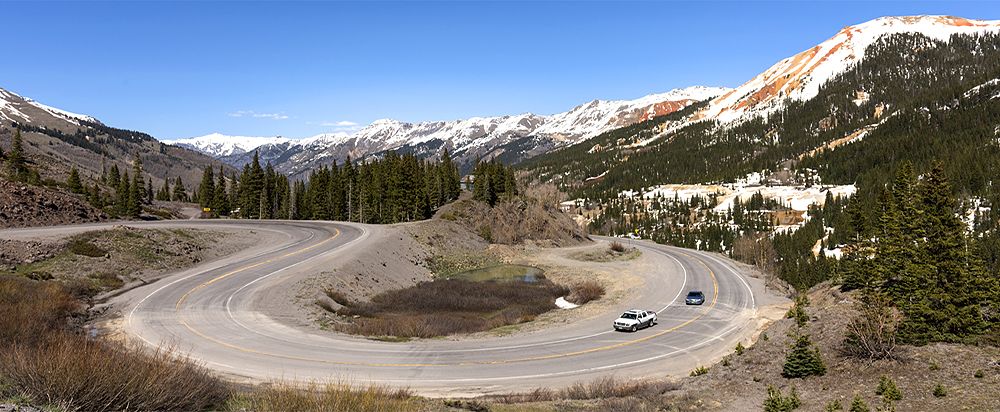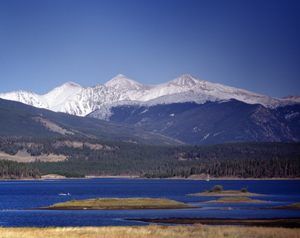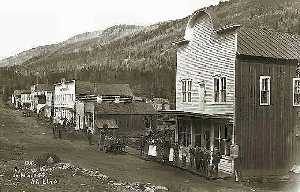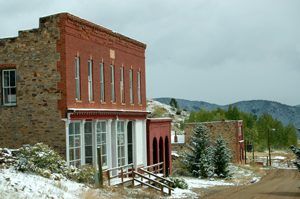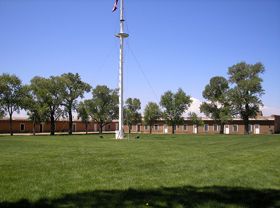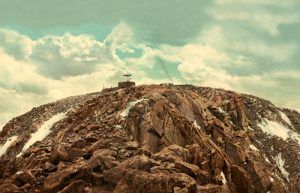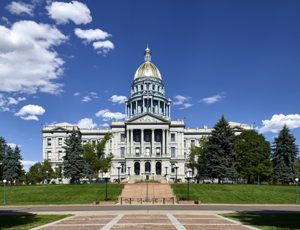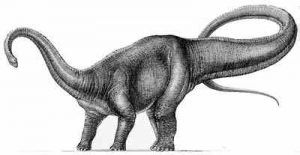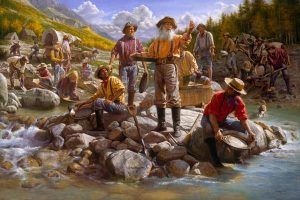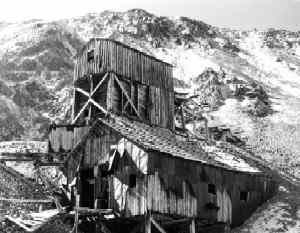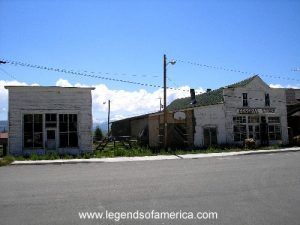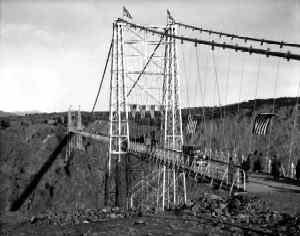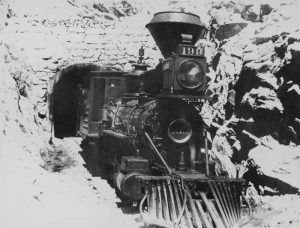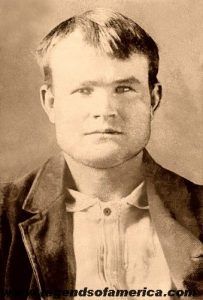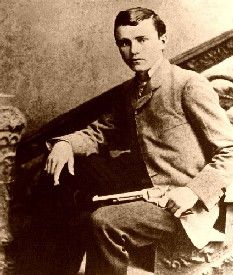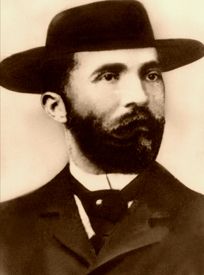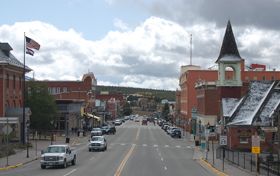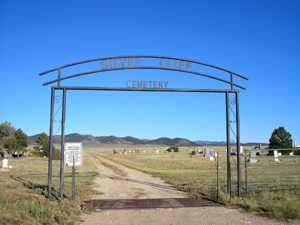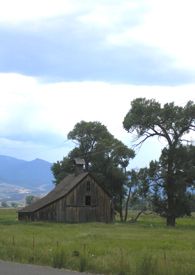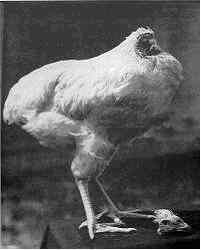
Mike, the headless chicken
The Town of Fruita, Colorado, wanted something other than the usual “pioneers” to focus on for Colorado Heritage Week, so the city revived the story of Mike, the Headless Chicken. In the 1940s, farmer Lloyd Olsen went to get a chicken for dinner. Wanting to leave as much of the neck as possible, he lopped off the chicken’s head as tightly as he could. However, because of a bad aim, the chicken did not die and continued to “peck” for food as it walked around the yard. Amazed, Olsen started feeding the chicken with an eyedropper. The headless bird, dubbed Mike, appeared in Life magazine and traveled to exhibitions around the country. Mike lived for 18 months after his head was chopped off. Today, Fruita’s Mike the Headless Chicken Festival is a great success.
On August 1, 1876, Colorado joined the Union. After President Andrew Johnson vetoed its first bid for statehood, President Ulysses S. Grant issued a proclamation declaring Colorado a state on August 1, 1876, the year the United States celebrated its centennial. Thus, the 38th state is known as the Centennial State.
Seventeen flags have fluttered over Colorado.
Amid the most mountainous state in the nation, a Tropical Bug Museum can be found southwest of Colorado Springs.
Colorado is the only state ever to turn down the Olympics. In 1972, they stunned the world when residents said they didn’t want the 1976 Winter Olympics. In a landmark vote on November 7, 1972, the voters said by a 62% percent majority that they were unwilling to host the Olympics because of the cost, pollution, and population boom it would have on the State Of Colorado and the City of Denver.
Guests stayed in Denver hotels at their own risk until the first hotel with locks on the doors opened in 1872. Reported one newspaper at the time: “Guests may lie down to peaceful slumbers, undisturbed by apprehensions of getting their heads blown off.”
The Smuggler II Mine near Aspen produced the largest silver nugget in the world in 1894. It weighed more than a ton.
Colorado has one of the only working diamond mines in the United States near the Colorado-Wyoming border.
Colorado has almost as many dead towns (about 500) as live ones (650). Mining booms and busts left the mountains littered with more than 300 ghost towns that fascinate locals and tourists. More than 200 ghost towns also haunt the eastern plains and western canyonlands.
In 1863, one of Nevadaville’s mines, the Pat Casey (later the Ophir), was sold to Wall Street speculators. Stock shares of Nevadaville’s mines were thus the first of any Colorado corporation to be quoted on the Big Board.
Millions of cattle came north along the Goodnight-Loving Trail, a 19th-century route from Texas through Colorado to Cheyenne.
The Buckhorn Saloon (est. 1860s) holds Denver Liquor License #1.
The largest building made out of ice in North America was built in Leadville in 1895. It covered more than 3 acres, with towers as high as 90 feet. Shaped like a medieval castle, it had two ballrooms and a 16,000-square-foot skating rink. Leadville’s Ice Palace opened January 1, 1896, but was forced to close two months later because of unseasonably warm weather. To read all about the Ice Palace, click here.
It is now a ghost town, but in 1861, Nevadaville outside Central City was larger than Denver.
Colorado’s youngest prisoner was 11-year-old Antone Woode, convicted in 1893 for murdering a neighbor. He served 12 years.
President Theodore Roosevelt signed his name in hotel registration books all over Colorado. Among them: Denver’s Oxford Hotel and the Brown Palace, and the Beaumont Hotel in Ouray. During his stay at the Hotel Colorado in Glenwood Springs, the Teddy Bear was allegedly invented when some hotel maids sewed and stuffed a toy bear for the president to cheer him up after a fruitless grizzly hunt.
On August 15, 1870, Kansas Pacific Railroad construction crews laid 10 miles of rail, the longest segment of track ever built in one day.
The ghost of Madge Reynolds is said to hang around the Reynolds Cottage at 1209 Logan Street in Denver. Years back, Madge and Fred Bonfils, then publisher of the Denver Post, were quite an item. They went horseback riding one day, and Bonfils is alleged to have spoken his true feelings for Madge, but she was married. She came home and was so overwhelmed by his proposal and his pursuit; she collapsed and died. Today, people report a ghost dressed in white inhabits the north side of the house, where she was happiest.
Before the Army built Fort Garland in Costilla County, there was a Fort Massachusetts. Its absurd location allowed Indians to stand on the bluffs and shower the soldier with arrows.
When Coronado sought the Seven Golden Cities in the West, he sent 15 men into southern Colorado. Upon reaching the area around Trinidad, they died from sheer exhaustion. A Spanish priest who discovered their remains named the area “Las Animas,” meaning “Souls in Purgatory,” because they died without receiving last rites.
Colorado leads all states in silver production.
In 1893, Colorado became the second state to grant women the right to vote. Perhaps one reason Colorado was the first state to popularly vote and approve women’s suffrage was because of sarcastic remarks made in local newspapers, such as: “Women would be content with smaller bribes than men, saving the candidates a great deal of expense.” and “Men have had a franchise so long and have made such a mess of it that women ought to be allowed a trial.
Katherine Lee Bates was inspired to write “America the Beautiful” from atop Pikes Peak.
Gus’s Place in Pueblo was listed three years running in Ripley’s Believe It or Not for serving more beer per barstool than any tavern in the world.
Colorado is nicknamed “the Centennial State” and was the 38th state admitted to the Union, entering on August 1, 1876.
Interstate 70’s Eisenhower Tunnel is the world’s highest auto tunnel (11,158 feet).
Denver families are the most likely families in any city in the U.S. to own three or more cars! Studies show that 11 out of 50 Denver families need three-car garages. That’s slightly ahead of the 1-in-5 rate in Oklahoma City, Dallas, San Diego, and Seattle.
Pikes Peak, elevation 14,109 feet, is the easternmost fourteener in the United States. The mountain has the largest elevation gain of any mountain in Colorado. The peak rises a staggering 7,800 vertical feet from downtown Manitou Springs in a horizontal distance of 7.25 miles. No other Colorado peak can match that. Over 400,000 people ascend Pikes Peak each year.
The largest diamond ever found in Colorado was a 28.3-carat gem found in 1996. The diamond was unearthed 43 miles northwest of Fort Collins at the Kelsey Lake Mine. This diamond was also the fifth-largest found in the United States. It was sized down into a 5.9-carat gem that sold for $87,000.
More than 300,000 people float Colorado’s rivers each year.
When the Littleton Creamery at 1801 Wynkoop Street added space in 1917, it was the largest cold-storage warehouse in the Rockies, with 1.2 million cubic feet of storage space. By 1929, it was said to be the third-largest in the nation. It remained a cold-storage business until 1981. Even after two years without cold-storage activity, it took seven (summer) weeks to defrost the walls; and ice was still 2 to 3 feet thick on the ceiling.
Colorado averages 300 days of sunshine annually.
Dead Man’s Canyon, 10 miles south of Colorado Springs, is haunted by the phantom of a man with an ax in his forehead. The “ghost” of William Harkins had haunted the area since 1863 when a gang of Mexican religious fanatics murdered him. Over the years, dozens of people have reported being chased by the angry phantom near his cabin on Little Fountain Creek.
Marble, Colorado, supplied the stone for the Lincoln Memorial and hundreds of other monuments and buildings. The largest block of marble ever quarried — a 100-ton chunk — came from Marble and now resides in Arlington National Cemetery and the Tomb of the Unknowns. During its 50-year period beginning in 1873, the marble quarry also supplied the Colorado Capitol, the U.S. Post Office in Downtown Denver and the Equitable Building in New York City. At the peak of production in 1914, the Colorado-Yule Marble Co. imported stonecutters from Italy to work in the two block-long finishing mill, then the world’s largest and now a national historic site.
White River National Forest became the first U.S. forest preserve in 1891.
The Latin phrase ~Nil Sine Numine~ is Colorado’s official motto, but throughout the state’s history, people have disagreed on its exact meaning. It is commonly translated as “Nothing without Providence.” Others say it means “Nothing without God.” In the early days, the pragmatic translated it as “Nothing without a new mine.” The translation most likely favored by the committee that adopted it in the first place is believed to be “Nothing without the Deity.”
Colorado contains 75% of the land area of the U.S., with an altitude of over 10,000 feet.
The United States federal government owns more than 1/3 of the land in Colorado.
The first dinosaur fossil discovered in Colorado was the skeleton of a Diplodocus, which was found on the ridge of the Hogback near Morrison in 1877. At the time of its discovery, it was the largest dinosaur skeleton known, measuring about 70 feet long, with a hipbone measuring nearly 8 feet long. However, there was no place in Denver to erect and house the skeleton at the time of the discovery, so it was shipped to a museum in New York.
A flat stone bearing the inscription “D. Grover and Joseph Fox Lawe, August 8, 1847” was discovered near Clifford many years ago. It served to revive the story of $100,000 in gold supposed to have been hidden by bandits on the plains south of Clifford during the California gold rush. As the story goes, eight bandits stole the money in Sacramento, California, in 1849 and secreted the gold in a gulch several miles east of Clifford. The burial spot was supposedly marked by three stones, each bearing the date 1847.
Colfax Avenue in Denver is the longest continuous street in America (40 miles).
During the Pikes Peak Gold Rush, Denver bankers Clark, Gruber and Co., John Parksons and Co., and J.J. Conway and Co. issued their own gold coins in $2.50, $5, $10, and $20 denominations. They were exchanged for loose gold. Clark, Gruber, and Co. also used paper money, inscribed with “Pikes Peak Gold.”
The Pike’s Peak Cog Railway is the highest railroad in the United States, at 14,110 feet.
Sugar beets were considered Colorado’s most important crop for much of the 1900s. Great Western Sugar, Holly, and National led the industry transforming the South Platte and Arkansas River valleys into beet kingdoms. During the Roaring ’20s, sugar beets beat out wheat as the state’s No. 1 crop.
The highest mountain pass road in the U. S. crosses Mosquito Pass (13,188 feet) between Leadville and Fairplay.
The greatest 24-hour snowfall ever measured in North America fell on Silver Lake — 76 inches on April 14-15, 1921.
The 6.2-mile-long Moffat Tunnel underneath the Continental Divide is the fourth-longest railroad tunnel in the world.
One of the West’s greatest hoaxes was the Solid Muldoon. It was “discovered” near Pueblo in 1877 and was passed off as the petrified body of an ancient man. The statue was of a man in a reclining position. It was 7 1/2 feet tall and weighed around 450 pounds. The figure had a short tail at the base of the spine, and the Solid Muldoon was touted as Darwin’s “missing link.” It was cast out of Portland cement.
San Luis, established in 1851 in Costilla County, is the oldest town in Colorado.
Damifino Park in Jackson County supposedly answers the question, “What’s the name of this place?”
A cloudburst struck the South Platte-Arkansas divide on May 21, 1878. It gorged the bed of Kiowa Creek at its head so that when the flood got nearly to Strasburg, it had attained immense volume and power. At that moment, a Kansas Pacific freight train was passing. The bodies of the Fireman and brakeman were found the next day a mile and a half downstream. The body of the engineer was recovered four days later, 10 miles downstream. Cars from the train were scattered, half-buried in the sandy bottom of the subsided stream for miles. However, searchers failed to find any sign of the locomotive, even after probing the shoals of the creek with long steel rods. In January 1989, novelist Clive Cussler led another party down Kiowa Creek with long steel rods searching for the missing locomotive. Bob Richardson, director of the Colorado Railroad Museum, contends the locomotive was recovered and in 1886 was still in service with the Union Pacific Railroad.
The highest suspension bridge in the world is over the Royal Gorge near Canon City. The bridge spans the Arkansas River at the height of 1,053 feet.
Old Town Fort Collins was the inspiration for California’s Disneyland Main Street.
Colorado has more microbreweries per capita than any other state. Fort Collins has the most microbreweries per capita in Colorado.
Since the Winter Games began in 1924, 133 Coloradoans have been Olympians. Steamboat Springs has produced 37 Winter Olympians, more than any other town in North America.
The Colorado Department of Transportation plows 5.8 million miles of highway each year. Forty-six plows serve Interstate 70 between Denver and Vail.
Harry Pritchard was attacked by a wild animal in the mountains north of Buena Vista, Colorado, in October 1904. Pritchard described the animal as having the appearance of a huge orangutan. A posse of hunters prepared to go into the mountains to capture the freak. They returned, saying they found nothing but “large footprints” lost in the higher rocked mountains.
The highest railroad tunnel in the U.S. is the now-abandoned Alpine Tunnel (11,546 feet) near St. Elmo, Colorado. It sits 11,500 above sea level and is 1,700 feet long. Seventeen thousand yards of granite and dirt were used in the construction and 400,000 feet of California redwood. The cost was $300,000.
Rufus T. Owens launched a submarine into Missouri Lake, three miles north of Black Hawk, in the autumn of 1898. The craft christened the Nautilus, immediately sank to the bottom of the lake. Owens left Central City within a year, never to be seen by locals again.
A watchman lived in the tunnels under the State Capitol building from the day it opened until his death 30 years later. He scrounged for food, wore the same overalls, and never openly spent money. He took his pay to the bank each month and exchanged it for silver dollars. When he died, searchers combed the tunnel looking for his silver, but they never found it.
As the Railroad progressed toward Denver in the mid-1860s, thousands of railroad workers had to be fed. A “catering” firm hired scores of hunters, most notably William Frederick Cody. In 17 months on the job, Cody roamed the plains, killing buffalo to feed the railroad crews. He counted the number of buffalo who died at this hand — a staggering 4,280, earning him the name “Buffalo Bill.” Throughout his life, he was a courier, pony express rider, stagecoach driver, wagon master, trapper, hunter, and Wild West Show promoter — introducing Annie Oakley Buffalo Bill Cody is buried atop Lookout Mountain, west of Denver, overlooking the Plains he loved so dearly.

Cace on the barroom floor at the Teller House in Central City, Colorado.
Legend has it that the “face on the barroom floor” at the Teller House Hotel in Central City was painted by Herdon Davis in 1936. He’d been hired to help with the remodeling of the hotel. However, when he fell out of grace with the owner, Anne Evans, he was banned from the Teller House and decided to leave a memento. The face painting is that of his wife, Edna Juanita Davis, and it had the intended effect, infuriating Evans.
Colorado is the highest of the 50 states, with an average altitude of 6,800 feet.
Butch Cassidy committed his first bank robbery in Telluride in 1889. Cassidy and his gang often hid in remote Brown’s Park in northwestern Colorado.
The Colorado legislature debated long and hard over which classical female figure should grace the top of the dome on the Capitol. With no agreement in sight, a glass globe was finally chosen to top off the Statehouse.
According to legend, a gold stash wrapped in a donkey skin lies buried atop Round Hill in Chaffee County.
When Denver built the Denver International Airport, “DIA,” it required the moving of 110 million cubic yards of earth even though it’s on a relatively level site. That is approximately one-third the amount of earth moved to build the Panama Canal. The airport is the largest airport in the country (53 square miles).
The highest paved road in North America is the Road to Mt. Evans off I-70 from Idaho Springs. The Road climbs up to 14,258 Ft. above sea level.
Threats of Indian raids nearly always evoked panic in early Colorado. One day in Denver, the town drunk found a spent arrow and pushed it through his hat. He rode through town on his mule howling, “The Indians are coming!” Terrified settlers fled to a downtown stockade. The drunk made the rounds of empty saloons, drinking free. Another inebriate in Central City tried the same trick. It worked for him, also.
Jesse James’s killer, Bob Ford, was himself gunned down in Creede. It happened when Ed O. Kelly, the marshal of nearby Bachelor, came into town, said he was a friend of the James brothers, then shot Ford, who was the owner of a bar and brothel, in the face.
State Senator S.T. Taylor reported spotting a UFO in the skies over La Veta at 10:30 a.m. November 25, 1955. He said the UFO was dirigible-shaped – fat in front and tapered toward the tail, was luminous green-blue and jellylike. Further, he reported that the object was diving at a 45-degree angle, then flattening out to a 45 degree before it disappeared about five seconds later.
A ghost known as Rufus haunts the Royal Hotel, built in 1903 in Yampa, Colorado. Legend says Rufus has lived there since 1918. Some say he died there during the 1918 flu epidemic when the hotel was a temporary infirmary. Others say he was shot when caught cheating at cards.
Boone, Colorado in Pueblo County was first called Booneville or Boonetown and took its name from founder and postmaster Albert Gallatin Boone. He was not only the grandson of Daniel Boone but also “a noted trapper, trader and Indian agent in his own right.”
Colorado has the last, and only un-named mountain peak in the U.S.A officially called “Unnamed 13,831.” The Federal Geological and Survey Agency said they could give it a name listing, but only after Colorado submitted its choice of name(s), which it has failed to do to date (2007).
In Cripple Creek, Colorado, a Brothel Museum offers admission for half-price to children ages 10-13 and free for children under ten. Children?? Go figure.
Jefferson Randolph “Soapy” Smith was king of the con men in Denver in the late 1880s. After setting up a stand at 17th and Larimer streets, Smith began promoting “the finest soap in the world.” He began inserting dollar bills into some of the soap-cake wrappers, but they went to Soapy’s confederates. With the soap proceeds, he opened the Tivoli Saloon and gambling hall at 17th and Market streets.
Minor league slugger Joey Meyer launched a 582-foot home at Mile High Stadium, believed to be the longest home run ever recorded.
Denver averages only 15 inches of annual precipitation.
Louis Ballast, owner of the Humpty Dumpty Barrel Drive-In, which was located at 2776 Speer Blvd. Denver spent the early years of the Great Depression trying to improve the taste of his hamburgers. He tried applying peanut butter, and that didn’t work. Then he tried melting a Hershey bar over a burger, and that proved even more awful. Finally, he settled on a slice of American cheese, and his customers fell in love with the “Cheeseburger,” a name he patented in 1935.
Leadville is North America’s highest incorporated town (10,152 feet).
Denver’s 26-square-block Lower Downtown District is the largest concentration of turn-of-the-century buildings in the country.
The dome atop the Colorado State Capital in Denver is covered with 200 ounces of gold donated by miners in the late 1800s.
The San Luis Alligator Farm is the highest-altitude alligator colony in the world.
The world’s largest elk rack hangs at Tony’s Conoco in Crested Butte.
Elias Willard Smith received from his father the opportunity to accompany fur trappers and traders to the Rocky Mountains for 11 months. He left the East Coast on August 6, 1839. On January 24, 1840, Smith and his companions left Fort Davy Crockett in northwestern Colorado to return to Fort Vasquez, just south of today’s Platteville. Winter caught them in the mountains, and they had to eat their horses or starve. The group sighted Fort Vasquez on April 24.
The Leadville 100 (held in late August) is the world’s highest 100-mile footrace.
Troublesome, Colorado, had the first woman postmaster in U.S. history.
On May 14, 1888, a Santa Fe freight train from Pueblo arrived at Colorado Springs in the wee hours of the morning, and the crew began unloading the first three cars. Unfortunately, the last five cars – including one carrying 18 tons of explosives and another carrying 3,000 gallons of naptha, a flammable liquid – became unhitched and headed back toward Pueblo on the down-sloping track. The runaway cars crashed into a northbound passenger train at Fountain, Colorado. The passenger train crew saw the cars coming, and most people escaped, but the resulting explosion blew a hole 15 feet deep and 35 feet wide and damaged nearly every building in Fountain. Three people were killed and 28 injured.
The first rodeo on record occurred at Deer Trail on July 4, 1869.
The ghosts of deceased pioneers are said to take to the form of blue lights that hover above graves in a cemetery in Silver Cliff, in South Central Colorado. The lights were first reported in 1882. Some say they are the “dancing blue spirits” spoken of in Indian legends. Edward Linehan of National Geographic investigated in 1969 and observed “dim round spots of blue-white light.” The lights are not reflections, and no radioactivity has been found. It may be electromagnetic in origin, but the lights persist to this day. For more information, see The Ghosts of Silvercliff.
A Metallic object was sighted flying from the northeast, then hovering above Manitou Springs for several minutes on May 19, 1947. The object then began a display of aerial acrobatics, diving, spinning, and climbing before speeding off into the afternoon sky. This is the earliest documented report of a UFO over Colorado.
Glenwood Springs boasts the world’s largest natural hot springs pool.
Georgetown and Silver Plume are just 2.1 miles apart, but the elevation difference is 638 feet. That’s a 6% grade — too steep for railroad trains to climb. Southern Union Pacific engineer Robert Blickensderfer designed a route that made it possible. The track covers nearly 4 1/2 miles (at a 3.5% grade), crossing over itself. The route (now famous) became known as the Georgetown Loop.
Among the ghostly inhabitants of Denver’s Oxford Hotel: a buckskin-clad man who comes and goes from the men’s room in the basement; a woman in a Victorian dress who glides down the main staircase; and a child who can be heard crying on one of the floors when maids clean the rooms.
Christopher O’Brian, the author of Enter the Valley, says the San Luis Valley, which stretches from Saguache to Taos, New Mexico, has America’s highest concentration of UFO sightings, crop circles, and Bigfoot sightings, as well as cattle mutilations and appearances of mysterious aircraft.
Mary Florence Lathrop, the first practicing female lawyer in Denver, opened her law office in 1897. Called “That Damn Woman!” by her male peers, she became the American Bar Association’s first female member in 1917. She practiced law in a lace apron until she died in 1951 at age 85.
John Stetson made his first Stetson hat in Central City in 1860.
Burlington’s Kit Carson Carousel (circa 1905) is the world’s oldest wooden merry-go-round.
The problem of stray dogs roaming Denver streets was so out of control by 1878 that police rented a wagon and went around shooting every stray within shotgun range — 103 the first week. Resident outrage overseeing wounded dogs dragging themselves down major thoroughfares halted the plan temporarily by 1883. After several children were attacked by dogs running in packs, police took up the shotgun patrol again.
The dandelion was introduced into Denver’s gardens in 1920 upon the recommendation of Dr. Fredrick Bancroft, who argued that the flower would beautify the city and provide medicinal benefits, as well as wine. By 1926, however, the flower proved to be a propagating pest. Residents of Denver campaigned to “exterminate the dandelion!” by offering unemployed people $3 a day to pick them.
Colorado ranks first among the 50 states in university degrees per capita.
Red snow was discovered atop Arapahoe Peak in August 1914. A writer discovered it while taking a class of university students to the top. At first, he thought someone was bleeding. The Red Snow comes from a one-celled plant organism called Chlaydomas nivalis. Red Snow is found only at high altitudes – seldom below 10,000 feet – in Colorado.
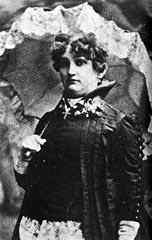
Mattie Silks
Denver madam Mattie Silks was a participant in history’s first duel between women. At a party on the night of Aug.25, 1877, a woman named Katie Fulton was making obvious advances toward Silks’ longtime love, Cortez Thomson. Incensed, Silks challenged Fulton to a pistol duel. The women paced, turned, and fired, whereby Silks missed Fulton entirely. Thomson screamed and fell, having taken a shot, probably from Fulton, in the neck. Thompson’s injury was just a flesh wound, and a brawl ensued. Fulton left by train for Kansas the next day, nursing a broken nose.
It wasn’t the Gold Rush or the silver boom of the last century that brought the most population to Denver and Colorado. It was tuberculosis. Thousands came here for the dry climate. “They were a much better class of people than the gold rush attracted,” historian Tom Noel said. “But the situation was hushed up by the city’s leaders. They didn’t want to be known as the place where thousands of people were walking around with a highly infectious disease.” Doc Holliday was one of those who came to Colorado for the climate. The line separating Colorado, Kansas, and Oklahoma wasn’t made official until 1990. Colorado’s southern border was disputed ever since Congress commissioned a survey in 1867 to determine what would become the line between Colorado and New Mexico. The line, named the Darling Line for the surveyor, was the 37th parallel north of the equator. However, it veered as much as a half-mile off course and was disputed by later surveys intended to draw the true line. A marker dedicated in September 1990 became the official point of reference for all future surveys. In the late 1800s, Denver was a huge gambling mecca. Bat Masterson was one of Colorado’s colorful gamblers. After serving as town marshal in La Junta and Trinidad, he returned to gambling at Ed Chase’s Palace Theater and gambling house in Denver. He married one of the dancers, but when gambling was outlawed in 1902, the two moved to New York City.
As many as 1,000 white spectators attended a Ute scalp dance, the last known in Denver, over several nights in July 1874 near Sloans Lake. News editors called the scene “barbarous.” They wrote: “It was disgusting to notice, among the spectators, lots of ladies, prominent in church and social circles, straining for a sight of the reeking scalps, which they scanned as eagerly as if they had been new bonnets.”
Compiled and edited by Kathy Weiser-Alexander/Legends of America, updated November 2021.
Also See:

